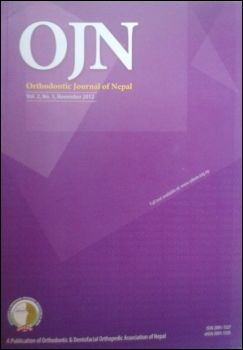Changes in Canine Angulation after Dentoalvelaor Distraction with a Rigid Maxillary Intraoral Distractor: A Radiographic Study
DOI:
https://doi.org/10.3126/ojn.v3i1.9283Keywords:
canine distraction, canine rotation and angulation, dentoalveolar distraction rigid distraction deviceAbstract
Introduction: Prolonged treatment duration is a major problem of orthodontic patients. Canine retraction through dentoalveolar distraction osteogenesis was introduced to reduce the overall orthodontic treatment period.
Objective: To evaluate the canine angulation by means of dentoalveolar distraction osteogenesis to achieve rapid canine retraction.
Materials & Method: The study sample consisted of 20 maxillary canines in 10 adult patients (mean age 19.53 years). First bicuspids were extracted, a rigid custom made intraoral distractor was placed, distraction osteogenesis surgical procedure was performed.
Result: Complete retraction of canines was achieved in a mean duration of 9.23 days with minimal anchorage loss. The mean change in canine angulation was 10.13° ± 3.44°. Bodily movements of the canines were noticed with minimal tipping of mean 7.11° (6°-8° range). No radiographic and clinical complications were encountered.
Conclusion: There was a significant change in canine angulation after distraction.
DOI: http://dx.doi.org/10.3126/ojn.v3i1.9283
Orthodontic Journal of Nepal, Vol.3, No.1, 2013: 53-57
Downloads
Downloads
Published
How to Cite
Issue
Section
License
Copyright © held by Orthodontic & Dentofacial Orthopedic Association of Nepal
- Copyright on any research article is transferred in full to the Orthodontic & Dentofacial Orthopedic Association of Nepal upon publication in the journal. The copyright transfer includes the right to reproduce and distribute the article in any form of reproduction (printing, electronic media or any other form).
- Articles in the Orthodontic Journal of Nepal are Open Access articles published under the Creative Commons CC BY License (https://creativecommons.org/licenses/by/4.0/)
- This license permits use, distribution and reproduction in any medium, provided the original work is properly cited.




